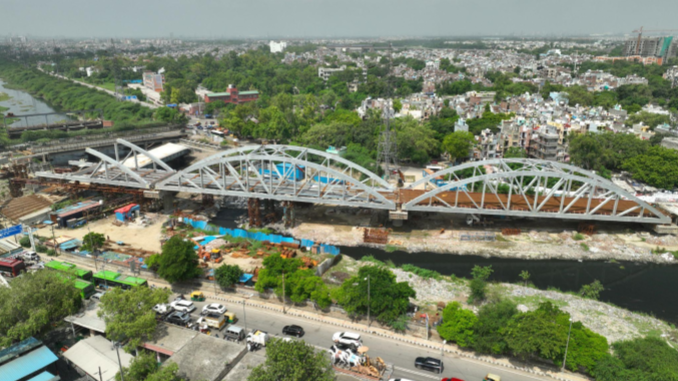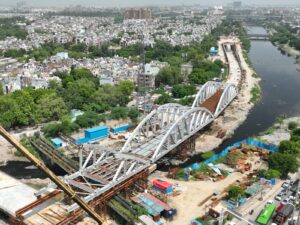
NCRTC has successfully installed two special steel spans for the RRTS Corridor in Kondali, Delhi. These special steel spans are part of a total of six special spans structures being installed to cross the Ghazipur drain from New Ashok Nagar towards Anand Vihar.
More Details:
- The combined length of these 6 special steel spans is 360 metres. This is the only place on the entire RRTS corridor where such a long viaduct is being constructed with steel spans.
- Out of these 6, two special steel spans have been successfully installed and work on the third is being done. These two special steel spans, weighing 540 tonnes have been installed in the Kondli area, near the New Ashok Nagar RRTS station.
- The RRTS corridor is progressing parallel to the Ghazipur drain. These special steel spans are being installed where the corridor will cross the drain. These spans will also cross over the road near Kondli Chowk. Out of these 6 special steel spans, the length of 3 spans will be approximately 70 metres each and the remaining 3 will be 50 metres each weighing 380 tonnes.
- The spans installed parallel to the Ghazipur drain is about 70 metres long and 14 metres wide. It was placed on the pillars, at a height of about 6 metres from the ground level with the help of big cranes.

- Another four spans to be installed in the area are under construction, out of which construction of another 70-metre-long span is almost 50 per cent complete. A little ahead of these spans in the direction of Khichripur, an underground ramp is being constructed, which will connect this elevated section to the underground Anand Vihar Station via Underground tunnels.
- NCRTC usually erect pillars at an average distance of 34 metres for the construction of an elevated viaduct of the RRTS corridor. These pillars are joined by precast segments with the help of a launching gantry (Tarini) to form the RRTS viaduct span.
- However, in some complex areas where the corridor crosses rivers, bridges, rail crossings, metro corridors, expressways or other such existing infrastructure, it is practically not possible to maintain this distance between pillars. In such areas, steel spans are being used to connect the pillars.
- The installation of the steel span near the 40-50 metres wide Ghazipur drain, which is flowing diagonally to the corridor alignment is a challenging task. Team NCRTC, following all the norms and taking all the precautions completed it successfully.
- Special steel spans are massive structures, consisting of beams made of structural steel. Segments of structural steel are first manufactured in the factory and then laden onto trailers brought to the site during the night to avoid any traffic problems.
- These parts are then assembled at the site by systematically joining together with the help of a special process. The shape and structure of these steel spans are specially designed to suit all the requirements of construction, installation and usage.
- So far 6 special steel spans have been installed on the Delhi-Meerut RRTS corridor, including a 50-metre-long span at Meerut on the Delhi-Meerut Expressway (DME), a 73-metre-long special span at Vasundhara on the main line of the railway, a 150-metre long span Steel Spans Near Ghaziabad station, two 45 m long steel spans for RRTS viaduct going towards Duhai Depot and 73 m long span for crossing EPE.
Source: NCRTC- Press Release | Images Credit: NCRTC

